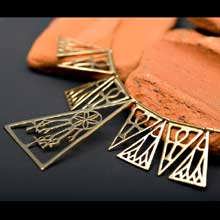
Ankh And Lotus Necklace Gold
An Ancient Egyptian Symbol of Eternity and the power of the Sun
Learn to acknowledge and appreciate the eternity of your soul
The Egyptian Ankh and lotus necklace includes the lotus flower. In ancient Egypt, the Lotus flower was used in many religious rituals probably of the mild psychoactive properties of this plant (the Blue lotus of the Nile-Nymphaea caerulea, also known as the Blue Egyptian water lily or sacred blue lily, is a water-lily in native to Egypt).
The Egyptian Lotus symbol was used as a symbol of the Sun and the afterlife since it's flower buds rise to the surface of the water over a period of 2-3 days and when ready open in the morning and then close in the afternoon.
The beautiful Lotus flower was also depicted as the original container from which Atom, the god of creation or the creator himself came into existence. Atum was considered to be the first god, having created himself, sitting on a mound from the primordial waters. Atum is the god of pre-existence and post-existence. In the binary solar cycle, the serpentine Atum is contrasted with the ram-headed scarab Khepri - the young sun god, whose name is derived from the Egyptian hpr "to come into existence". Khepri-Atum encompassed sunrise and sunset, thus reflecting the entire solar cycle.
Atum was a self-created deity, the first being to emerge from the darkness and endless watery abyss that girdled the world before creation. A product of the energy and matter contained in this chaos.
The second symbol of the necklace is the Egyptian Ankh, known as the key of life. The middle piece is the ancient symbol of the Aten-the Sun Sphere - the source of all life which became the only symbol of religious significance during Amenhotep IV, who later took the name Akhenaten in worship and recognition of Aten. In his poem "Great Hymn to the Aten", Akhenaten praises Aten as the creator, and giver of life.
The sun wheel in the necklace appears in the form of the seed of life which is the geometric pattern of creation itself.